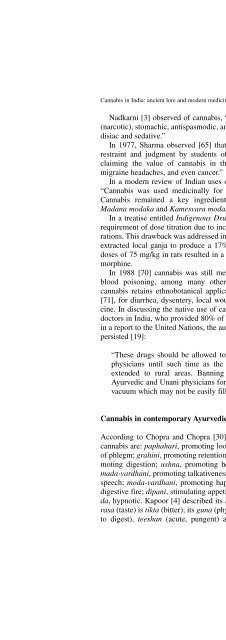3. Umbruch 4.4..2005 - Online Pot
3. Umbruch 4.4..2005 - Online Pot
3. Umbruch 4.4..2005 - Online Pot
You also want an ePaper? Increase the reach of your titles
YUMPU automatically turns print PDFs into web optimized ePapers that Google loves.
Cannabis in India: ancient lore and modern medicine 11<br />
Nadkarni [3] observed of cannabis, “All parts of the plant are intoxicating<br />
(narcotic), stomachic, antispasmodic, analgesic (anodyne), stimulating, aphrodisiac<br />
and sedative.”<br />
In 1977, Sharma observed [65] that “even today [cannabis] is used with<br />
restraint and judgment by students of Indian medicine. There are reports<br />
claiming the value of cannabis in the treatment of high blood pressure,<br />
migraine headaches, and even cancer.”<br />
In a modern review of Indian uses of cannabis, it was observed [66] that<br />
“Cannabis was used medicinally for almost all the ills flesh is heir to”.<br />
Cannabis remained a key ingredient in two aphrodisiacal preparations,<br />
Madana modaka and Kamesvara modaka [67].<br />
In a treatise entitled Indigenous Drugs of India [68] the authors noted the<br />
requirement of dose titration due to increasingly inconsistent cannabis preparations.<br />
This drawback was addressed in a prior study [69] in which the authors<br />
extracted local ganja to produce a 17% THC yield, which at intraperitoneal<br />
doses of 75 mg/kg in rats resulted in a potentiation of sub-analgesic doses of<br />
morphine.<br />
In 1988 [70] cannabis was still mentioned as a remedy for malaria and<br />
blood poisoning, among many other indications. In neighboring Nepal,<br />
cannabis retains ethnobotanical applications among some 15 ethnic groups<br />
[71], for diarrhea, dysentery, local wound treatment and in veterinary medicine.<br />
In discussing the native use of cannabis and opium products by village<br />
doctors in India, who provided 80% of the population with their medical care<br />
in a report to the United Nations, the author felt that a legitimate role for them<br />
persisted [19]:<br />
“These drugs should be allowed to be used by Ayurvedic and Unani<br />
physicians until such time as the benefits of modern medicine are<br />
extended to rural areas. Banning their use by the large mass of<br />
Ayurvedic and Unani physicians for therapeutic purposes may create a<br />
vacuum which may not be easily filled for a long time to come.”<br />
Cannabis in contemporary Ayurvedic medicine<br />
According to Chopra and Chopra [30], the modern Ayurvedic properties of<br />
cannabis are: paphahari, promoting loosening, separation and the elimination<br />
of phlegm; grahini, promoting retention and binding the bowels; pachani, promoting<br />
digestion; ushna, promoting heat; pitala, exciting the flow of bile;<br />
mada-vardhani, promoting talkativeness or releasing the volitional restraint of<br />
speech; moda-vardhani, promoting happiness; vag-vardhani, stimulating the<br />
digestive fire; dipani, stimulating appetite; ruchya, promoting taste; nidraprada,<br />
hypnotic. Kapoor [4] described its Ayurvedic attributes as follows [4]: its<br />
rasa (taste) is tikta (bitter); its guna (physical properties) are laghu (light, easy<br />
to digest), teeshan (acute, pungent) and rooksha (ununctuous); its veerya







